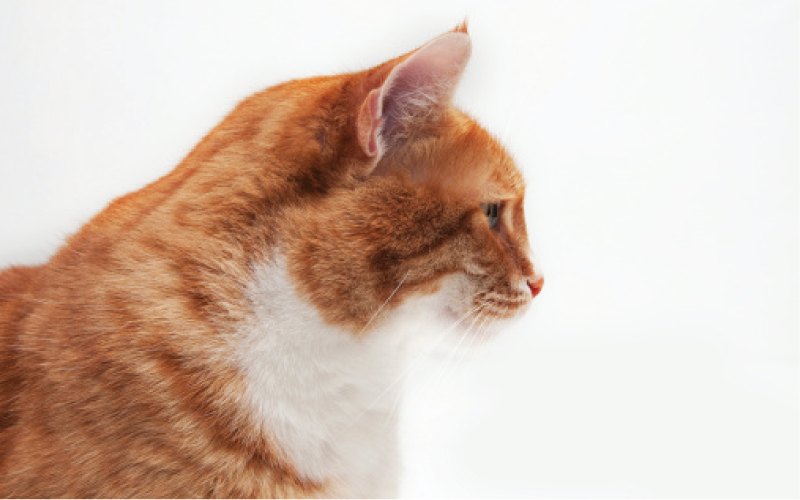We’ve put together this blog you can share on your practice website, that highlights education about feline health and how to keep your kitty slim.
Check out our Facebook Live with Dr. Mark Stephenson discussing the importance of feline obesity and other healthy cat tips.
It starts innocently enough. You give your cat a few extra treats because she is meowing incessantly, and you don’t know what else to do. The next day, she meows again, so you give her more – after all, they worked like a charm! The day after, it’s a few more or even an extra spoonful of cat food, and before you know it, your once-trim cat is slim no more.
If this isn’t your story, it’s certainly a common one. According to VCA Hospitals, approximately 30-35% of the general feline population is obese, with 50% of cats aged 5-11 years old weighing in higher than what’s ideal. And feline obesity is increasing! According to studies by the Ontario Veterinary College (OVC), the average cat’s weight is now higher than it was in the 1990s.
“Treats can have a big impact on weight for their animals,” said OVC lead research author Adam Campigotto in an interview with The Star, adding that people often associate giving treats as a kind of love. And indeed, treat-giving can come from a place of sincere affection. Yet when too many treats add up to a fat cat, all that affection can pose serious, and even life-threatening, health risks, including:
- Diabetes
- Osteoarthritis
- High blood pressure
- Heart disease
- Urinary bladder stones
- Anesthetic complications
- Cancer
Overall, obesity has been shown to shorten a cat’s lifespan; even being moderately overweight can reduce life expectancy. According to VCA Hospitals, a 2.8-fold increase in mortality has been shown in cats (8-12 years of age) that are obese (as compared to those that are lean).
One of the biggest challenges for pet owners is that cats tend to hide the symptoms of illness, which is probably part of their survival instinct according to Dr. Stacy Eckman, clinical assistant professor at the Texas A&M College of Veterinary Medicine & Biomedical Sciences. So, you may not know that your cat has obesity-related health problems until they’ve reached a critical point (or advanced too far).
To protect your cat from obesity-related health risks, here are five tips to help you keep your cat at a normal healthy weight.
1. Know Your Cat’s Ideal Weight
While many online sources say that a cat’s ideal weight should be around 8-10 pounds, the ideal weight for a cat depends on its body frame size. Most veterinary practices use a body condition scoring system on a scale of either 1-5 (with 3 being normal) or 1-9 (with 4.5 being normal). If you don’t know whether your cat is at an ideal weight, your veterinarian will be happy to provide you with an assessment.
2. Play With Your Cat
Just like people, cats can get bored. And in response, they might think, “I’ll just go get a bite to eat.” If nothing’s in their dish, “I’ll go bother Mom/Dad for something.” And when they do (this is where the meowing comes in!), many Moms and Dads will give in. Instead, spend some time playing with your cat. Get out those crinkle balls or one of those fishing-rod toys. Or just flick a crunched-up ball of aluminum foil across the room for your cat to chase. Your cat doesn’t really care what kind of toy you use. She will simply be jazzed that it’s playtime with you and burn off a few calories in the process.
3. Use a Dispensing Toy
Place a portion of your cat’s daily dry food into a treat ball or other dispensing toy. Batting around a treat ball provides fun and exercise for a food-motivated cat. Such toys also act as puzzles to cats, both keeping their brains sharp and warding against boredom. Or try hiding pieces of dry cat food around the house to satisfy the hunter in your feline friend.
4. Regularly Weigh Your Cat
Weigh your cat every 2-3 weeks (or at minimum, once per month). Regular weigh-ins are an important part of successful weight loss programs and keeps everyone accountable. Weight Watchers® has been using this principle for decades. It’s important to have your cat’s weight loss assessed by your veterinarian to ensure that it’s neither too rapid nor excessive and to determine when enough has been lost.
5. Maintain Your Cat’s Weight
Once your cat has achieved ideal body weight and condition, it’s important to maintain it. Your veterinarian can help you choose an appropriate food and provide portion size for weight maintenance. Portion control is critical at this stage to prevent your cat from regaining weight. Yo-yo loss and gain for cats is no healthier than it is for humans. The benefits of normalizing and maintaining your cat’s weight make the effort more than worthwhile.
You can also download our Complimentary Feline Obesity Awareness Kit, complete with tools you can use in your practice to drive awareness around healthy cats.
Download Your Complimentary Kit






